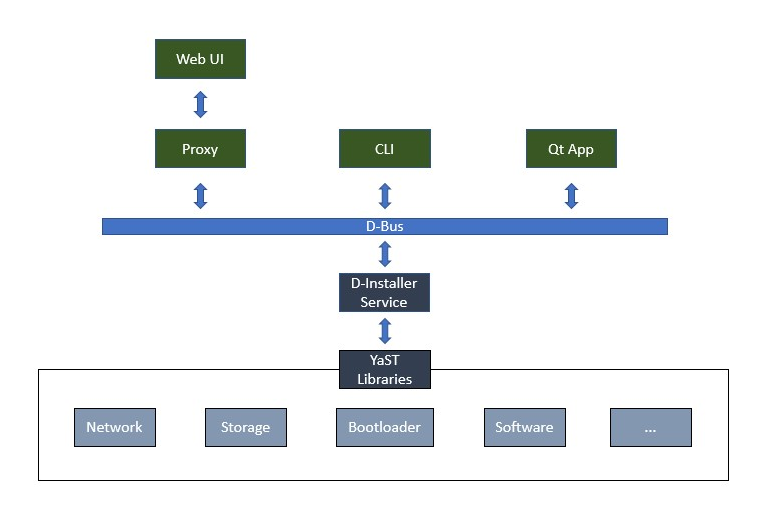Announcing the D-Installer Project
As you may know, YaST is not only a control center for (open)SUSE Linux distributions, but it is also the installer. And, in that regard, we think it is a competent installer. However, time goes by, and YaST shows its age in a few aspects.
During summer 2021, the team discussed how YaST should look in the near future. We considered many ideas, but let's focus on these:
- Shortening the installation process.
- Decoupling the user interface from YaST internals.
- Adding a web-based interface. We had WebYaST in the past, but it was not meant to work as installer.
We played around with these ideas (e.g., see $INSTALLER:80 and making openSUSE installer shorter), but we never had a concrete plan.
Fast-forward to December: before the holidays, we decided to resume our research and build a proof of concept of a web-based installer. We created something simple enough that, to be honest, does not even work at all. But after discussing the overall approach at a team meeting in January, we thought it might be a good idea to invest more time into it.
However, before jumping into coding just "something", we want to take our time to define the project in the right way, build a plan and ask for feedback.
It is not just about the user interface
Providing an alternative web-based interface is just the tip of the iceberg. Before doing that, we need to make many internal changes, like decoupling the user interface code or adding a D-Bus interface.
Fortunately, we already have improved YaST internals in several vital areas (storage, networking, etc.). However, we are not there yet: a lot of work remains to be done.
The diagram below outlines the main components of the idea. Of course, it might change as the project evolves, but it looks good as a starting point.

Benefits
Following this approach, we can foresee many benefits for YaST. To name a few:
- A better user interface: libYUI has served us well. However, it imposes some limitations that we would love to overcome.
- Reusability: YaST contains a lot of helpful logic that would be available to other tools.
- Better integration: It should be easier to integrate pieces of YaST in your own workflows by providing a D-Bus interface.
- Multi-language: Eventually, using D-Bus might allow us to use other programming languages.
- Contributors: We expect more people to contribute to the project by making the code more accessible and using widely-known technologies.
Q&A
We expect you have questions, right? So let's try to anticipate some of them.
Are you deprecating the current user interface?
No. We just want to offer an alternative and somehow simplified interface. Actually, we do not expect the web-based UI to be as powerful as the current one in the short term.
Which modules would get the new interface?
At this point, we are limiting to the installer. We do not plan to add a web-based interface to any other module.
What about AutoYaST?
Regarding AutoYaST, the idea is to use the same codebase as the standard installation while keeping the backward compatibility. So you could reuse your AutoYaST profiles with no significant issues.
Are you moving from Ruby to another language?
No. We just thought that, in the future, it might be possible to reimplement parts of YaST (or write new pieces) in a different language. But we do not plan to replace Ruby in the short term.
When will it be released?
We do not know yet.
Isn't precisely that what Anaconda developers are doing?
Mostly yes. We were glad to read their announcement because it somehow validates our point of view about the future. But, of course, Anaconda is in a better position (e.g., it already features a D-Bus interface).
Would you rely on Cockpit?
We do not know yet, but... why not? Cockpit is a really nice project and we have already released a module for Wicked. So perhaps we could seek some collaboration.
Why is called D-Installer?
Well, it is just a play on words. We named the repository as "yast/the-installer" and, given that it is a service-based installer, it evolved to d-installer. Of course, not even the name of the project is set in stone, so we are open to better proposals. 😉
Conclusion
We are in the early stages of an exciting project that should take us to redefine the future of YaST. And, of course, we would love to hear from you. So, please, do not hesitate to contact us if you have any comments or questions.
Have a lot of fun!